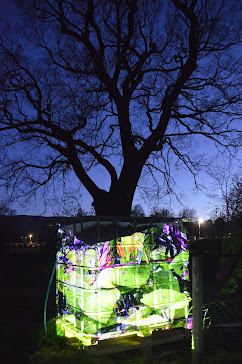None of the images in the Casenotes series relates to the experiences of any specific individual. There are stories I carry with me, but these have been processed and filtered through multiple narratives in a way that ensures that no identifying trace remains, though it's quite possible that some images in the series will resonate more than others with particular viewers.
My own memories and imaginings have been combined with and filtered through material such as found imagery from dismantled medical books, remaindered from hospital libraries, but chiefly via a found book of handwritten hospital records from 1946, between the end of World War 2 and the establishment of the National Health Service. This book, subsequently used as a footballing scrapbook, holds fragments of hospital records, charting day and night progress of recovery or decline, overlaid with 1950s press cuttings of football and footballers. I've been intrigued by the strange correspondence between the images and language of sport and health, and have drawn from the book in Casenotes.
Paper is particularly suited to themes of damage, repair, reparation in the way it can receive many media, be cut, incised, glued and layered. The papers used in Casenotes are integral to the process, content and resonance of the work: manila folders, suspension files, perforated computer paper are often the repositories of and transmitters of sensitive material and personal stories encapsulated in case notes. The trace or evocation of past use is an imaginative stimulus, but the paper also provides a shape or frame to the work - a given format alongside endless permutations of content. Using storage systems as materials expands a metaphor for the way the psyche develops within imposed external frameworks, and reflects societal drives to systematise and control unpredictable human forces.
Whilst I consider drawing to be at the heart of my practice, I am a multi-media artist, using video, painting, photography, sound and sculptural elements, often in the form of found objects. Whatever the media/scale and whether digital or analogue my work revolves around a fascination with internal states of being: alive to the promptings of chance, fantasy and emotion, it seeks out correspondences between the material world and the hidden crannies of the psyche.
This body of work has been shown in Concentric@tactileBOSCH Lounge and in Thoughts on Paper at Oriel y Bont, Pontypridd.
To see some individual images from this series go to https://pennyhallas.co.uk/wp/artwork/casenotes/















































